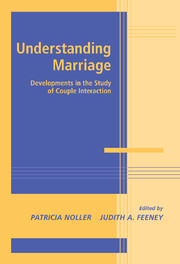Book contents
- Frontmatter
- Contents
- Contribitors
- Introduction
- SECTION ONE THE EFFECT OF COGNITION ON INTERACTION PATTERNS
- SECTION TWO UNDERSTANDING THE IMPORTANCE OF POSITIVE INTERACTION
- SECTION THREE COPING WITH DISAPPOINTMENT, CRITICISM, AND BETRAYAL
- Introduction to Section Three
- 8 Coping with Disappointment in Marriage: When Partners' Standards Are Unmet
- 9 On Empathic Accuracy and Husbands' Abusiveness: The “Overattribution Bias”
- 10 The War of the Roses: An Interdependence Analysis of Betrayal and Forgiveness
- SECTION FOUR POWER, CONFLICT, AND VIOLENCE IN MARITAL INTERACTION
- Marital interaction at important transition periods
- SECTION SIX Interventions for strengthening relationships
- Conclusions
- Index
- References
10 - The War of the Roses: An Interdependence Analysis of Betrayal and Forgiveness
Published online by Cambridge University Press: 25 July 2009
- Frontmatter
- Contents
- Contribitors
- Introduction
- SECTION ONE THE EFFECT OF COGNITION ON INTERACTION PATTERNS
- SECTION TWO UNDERSTANDING THE IMPORTANCE OF POSITIVE INTERACTION
- SECTION THREE COPING WITH DISAPPOINTMENT, CRITICISM, AND BETRAYAL
- Introduction to Section Three
- 8 Coping with Disappointment in Marriage: When Partners' Standards Are Unmet
- 9 On Empathic Accuracy and Husbands' Abusiveness: The “Overattribution Bias”
- 10 The War of the Roses: An Interdependence Analysis of Betrayal and Forgiveness
- SECTION FOUR POWER, CONFLICT, AND VIOLENCE IN MARITAL INTERACTION
- Marital interaction at important transition periods
- SECTION SIX Interventions for strengthening relationships
- Conclusions
- Index
- References
Summary
Barbara and Oliver Rose – I think you should hear their story … I won't start the clock yet. My fee is $450 an hour. When a man who makes $450 an hour wants to tell you something for free, you should listen.
–Gavin D'Amata, The War of the RosesGavin D'Amata is a divorce lawyer. With the preceding words to a prospective client, Gavin begins to recount The War of the Roses, a (sometimes hilarious) marital cautionary tale. The unfolding narrative reveals the troubled marriage of Barbara and Oliver Rose: Oliver belittles Barbara's career; Barbara neglects Oliver during a frightening health crisis; each humiliates the other, delivering impossible-to-forget attacks on the other's tastes and habits. During their marital Armageddon, Barbara and Oliver become entangled in a chandelier suspended above a hallway. The mechanism supporting the chandelier gives way, and – embraced in the arms of the chandelier – the two crash to the unyielding terazzo floor 30 feet below. With his dying breath, Oliver reaches out to touch Barbara's shoulder, offering amends and seeking forgiveness. Barbara's hand slowly rises to meet Oliver's … (perhaps, one imagines, to reciprocate Oliver's act) … and with her dying breath, Barbara flings Oliver's hand away from her.
Why is the Rose marriage interesting, from a scientific point of view? The Roses are interesting because their marital woes do not stem from the sorts of faulty communication patterns traditionally emphasized in marital research – patterns involving negative reciprocity, demand-withdraw, or coercive interaction (cf. Gottman, Coan, Carrere, & Swanson, 1998).
- Type
- Chapter
- Information
- Understanding MarriageDevelopments in the Study of Couple Interaction, pp. 251 - 282Publisher: Cambridge University PressPrint publication year: 2002
References
- 8
- Cited by



